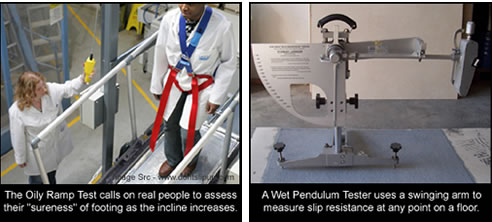NEWS ARTICLE ARCHIVESAnti-Slip Flooring Information from FLOORChef #TwoStandards A one-minute article to stop slipping up on anti-slip floors #TwoStandards When it comes to anti-slip flooring, the majority of clients contact us armed with an "R" rating they're adamant should be on their floor. Despite their conviction, we find most don't fully understand how it relates to their floor. Because of this, we'd like to take a few steps back in our first article to broadly discuss what the standard actually means. It's not all about the "R" There are two popular tests for quantifying slip resistance. By far the most common reference is to the Oily Ramp Method, which is a laboratory test gauging sureness of footing by producing the well-known "R" rating (from R9/light anti-slip to R12 or 13/aggressive anti-slip). The other is the Wet Pendulum Test, which is used as the Australian Standard (AS) for field testing of existing surfaces ("Z" rating/very high slip risk to "V" rating/very low slip risk). The key differences are summed up by two sets of words above - oily and wet, laboratory and field. When you're talking about an "R" rating, you're talking about a measurement made in a laboratory using an inclined, oily surface with the aim of replicating that slip resistance in the field (Note - there's no way of actually confirming this once applied). The Wet Pendulum Test, on the other hand, has more to do with the field. Portable equipment is used to take the readings on any part of a floor, new or old, and assess the slip resistance at that point when the surface is wet. Which one should I use? What can be taken from all that? Well, perhaps the main message is that the two standards aren't interchangeable and anti-slip specification needs to consider what standard is more appropriate. Will the floor be exposed to oil and/or applied on an inclined surface? Is water the only liquid that will come into play? The CSIRO publishes recommendations for anti-slip requirements with both standards in mind, however it's important to use the one that matches your application best. Finally, an important distinction we like to make when discussing the basics of anti-slip flooring relates to our preference for using "anti-slip" or "increased slip resistance" as opposed to "non-slip". Unless you can guarantee the floor prevents slips and falls in every scenario, "anti-slip" is perhaps the more accurate description of what can be achieved at the end of the day. If you have any questions about anti-slip standards, please don't hesitate to contact me directly. Keep Smiling,
Jack Josephsen For more articles on anti-slip flooring, visit the YESChef! Blog |
 |
 |